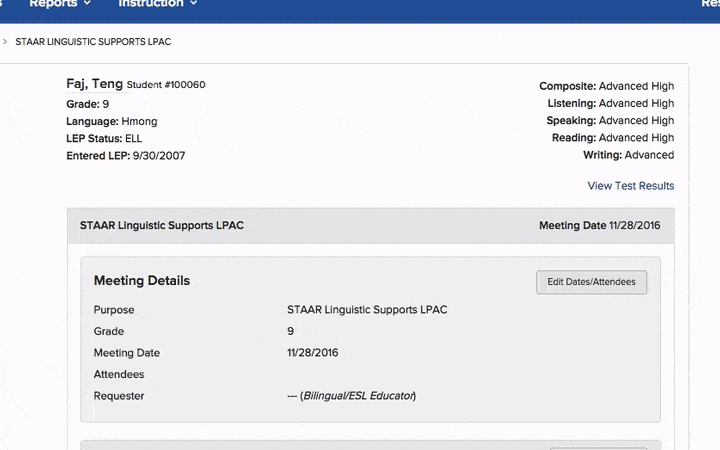A New Workflow Makes Approving STAAR Test Accommodations Easier
Educators in Texas face a daunting challenge when it comes to serving English learners. In Dallas, for example, one out of every three students is a non-native speaker. According to the Migration Policy Institute, Texas was home to nearly 810,000 ELs in 2014, meaning the state has the second largest EL population nationwide.
Given the sheer size of the challenge, we’re well aware that administrators and educators are constantly innovating, always searching for an edge. They understand that program inefficiencies adversely affect a considerable cohort of their students, whereas operative enhancements have the power to scale change for good.
The following interview uncovers one new way Ellevation hopes to help our Texas partners produce comprehensive improvement. Here to explain is one of our most experienced Partner Success Managers, Courtney Weber.

Before we get started, can you please explain what linguistic testing accommodations are for our non-Texas readers?
Linguistic testing accommodations (now called “supports”) are available during STAAR and TELPAS administrations to eligible ELs who use them routinely, independently, and effectively in the classroom.
What are some of the biggest pain points Texas districts experience today as it pertains to recommending linguistic accommodations?
Oh, where do I begin? For districts large and small, gathering feedback from teachers regarding what supports ELs have been using routinely, independently, and effectively has been a challenge. For most of the districts we serve, it’s the Language Proficiency Assessment Committee (LPAC) facilitator’s responsibility to work with educators to gather this feedback. This process often includes methods such as visiting with teachers individually, attending multiple PLC meetings, delivering (and then collecting) feedback forms, or setting up a massive shared Google doc where educators enter recommended supports. Most of these methods require teachers to document their recommendations in one space, and then have the LPAC committee enter that same information on official LPAC documents. No matter what method is chosen, this means not as much time can be devoted to documenting other crucial information such as how often and how effectively the support is used. For many districts, this results in LPACs making final decisions without important context and students receiving supports that might not be commensurate with their needs.
Okay, so what has Ellevation done to address these challenges?
For districts that purchase Ellevation Collaborate, classroom teachers are notified by email when the LPAC facilitator requests recommendations for linguistic supports for their students. Recommendation forms are easy to complete, and they provide a designated space for teachers to document why their recommended supports are appropriate for each student.
Once forms are submitted by classroom teachers, the LPAC users see those completed recommendation forms for any given student while conducting their Assessment LPAC and can determine whether to approve or reject those recommendations. Better yet, approved supports will automatically populate the student’s Test Accommodations tab! No paper chasing. No double entry. Just collaborative, fully-informed decision making.

What kind of impact do you expect this feature to have on a classroom teacher? On an LPAC Facilitator? How about on an English learner?
I’m really excited about how simple this process is for classroom teachers. Whether they submit their recommendations in a computer lab during their conference period or from the comfort of their homes, the recommendation forms can be accessed from Ellevation and take mere moments to complete. I also love that teachers can see which linguistic accommodations have been documented in Ellevation for the student in previous years, along with historical TELPAS and STAAR scores. Teachers have a comprehensive view of each student as they provide their feedback to the LPAC committee.
Of course, it’s the LPAC facilitator who will really feel the time-saving benefit of a streamlined online process. Instead of racing against the clock to gather, sort, and decipher classroom teacher feedback, the LPAC will be able to use this time to review, discuss, and decide. I love that communicating these decisions back to classroom teachers requires zero time and effort for the administrator, as classroom teachers will see approved supports when they log in to Ellevation.
When less time is spent on the logistics of the Accommodation LPAC process and more time is devoted to making purposeful LPAC decisions, districts can breathe a sigh of relief in knowing that ELs will receive exactly the support they need during state testing to help them achieve proficiency rather than inadvertently hold them back.
Can we see the new workflow in action?
Yes! We’ve recorded a live demonstration of the new testing accommodations workflow. You can access the 15 minute demo from this page here.
